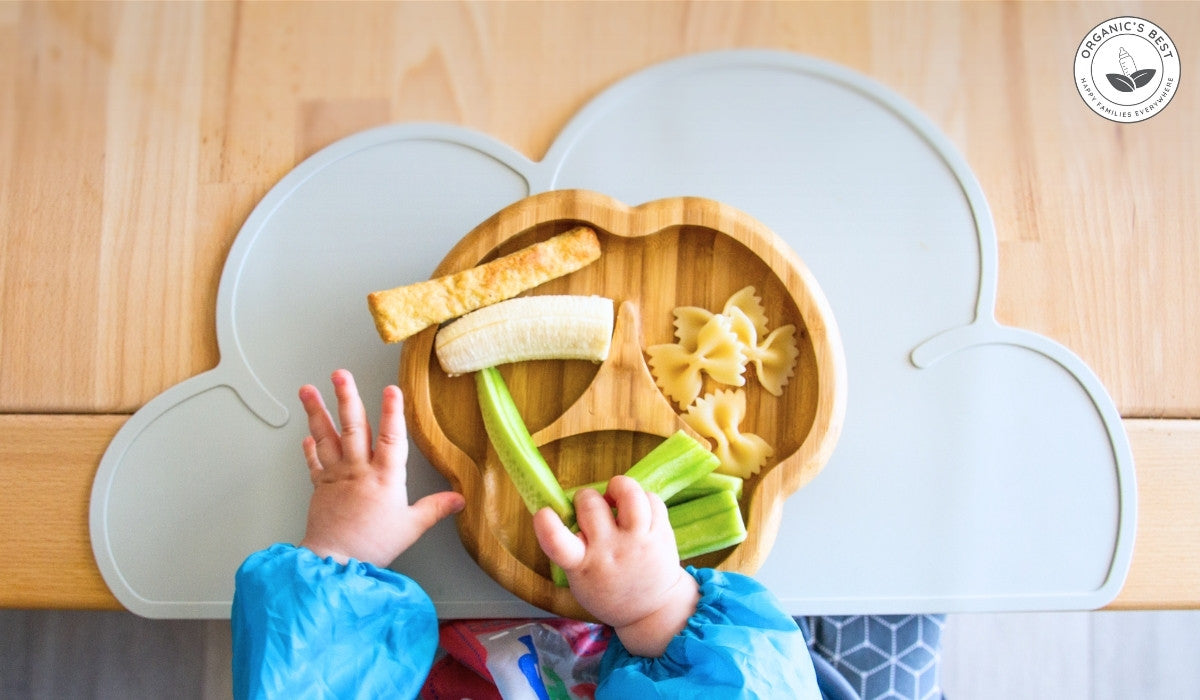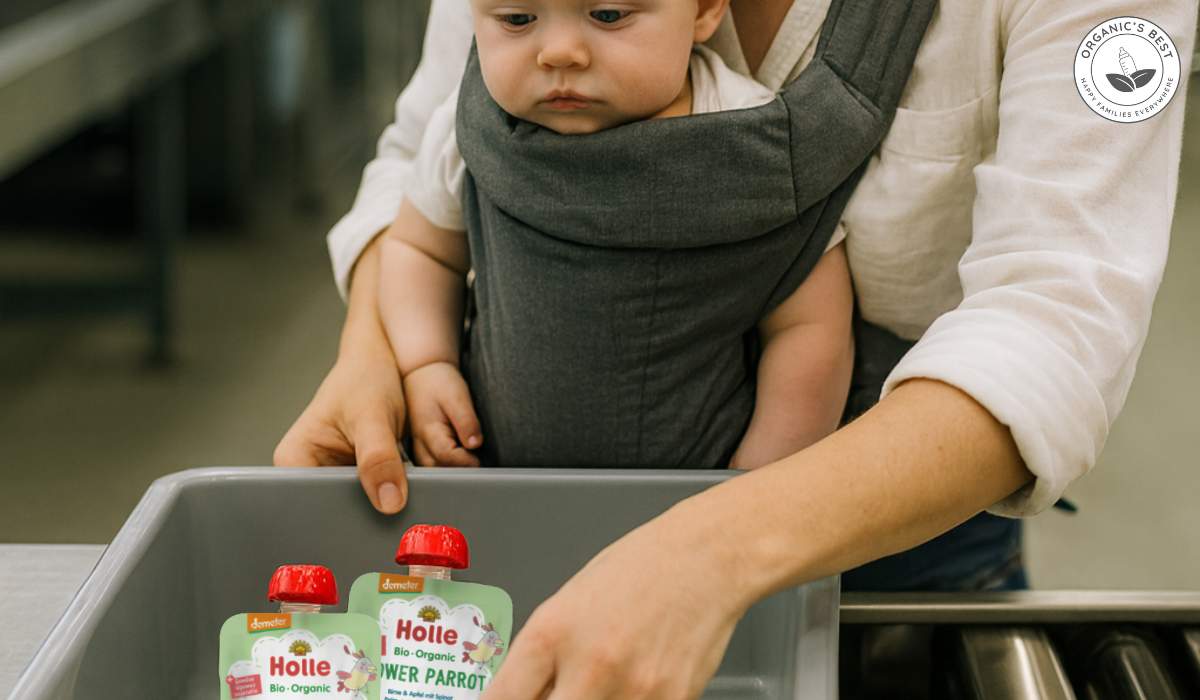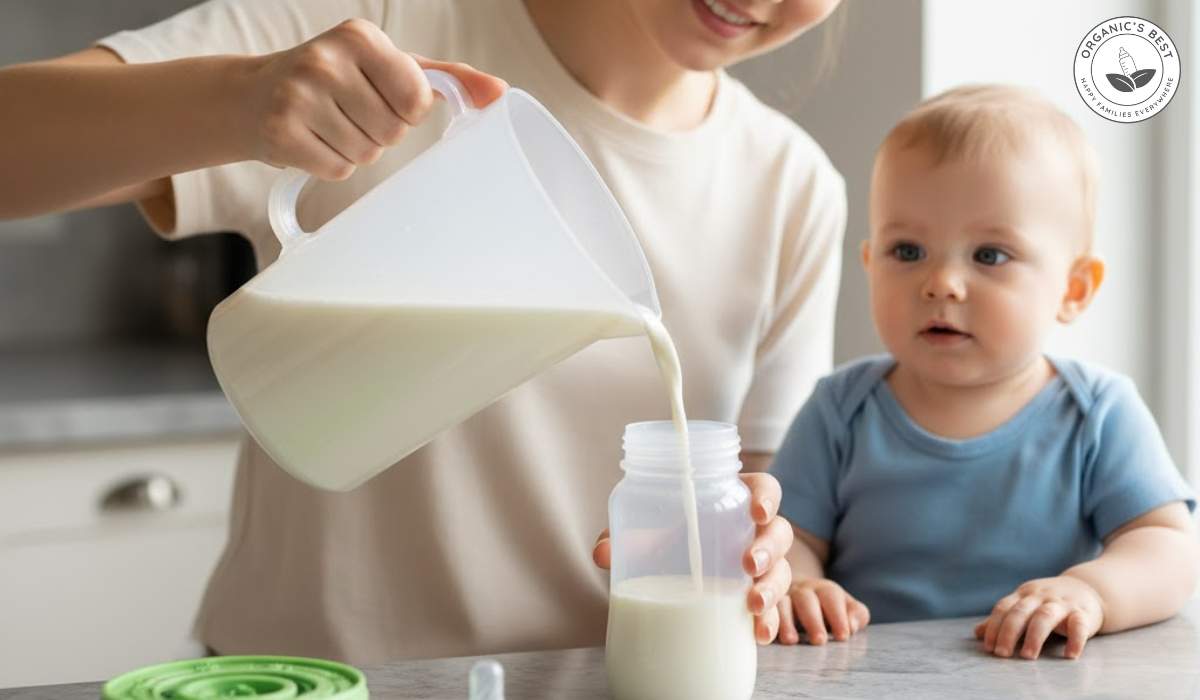Click to Get 2 FREE Boxes/Cans
Click to Get 2 FREE Boxes/Cans
Only New Customers! Click HERE to Get 2 Extra Boxes/Cans for Free With Your First Order.
Only New Customers! Click HERE to Get 2 Extra Boxes/Cans for Free With Your First Order.
BABY FORMULA
Offering new parents top-quality European infant formula from renowned brands like HiPP, Holle, Kendamil, and more. If you’re uncertain about which product to choose, our Formula Finder can help you make the best decision for your baby.
Baby Food
Offering new parents a premium selection of European baby foods, including jars, pouches, cereals, and snacks from esteemed brands like HiPP and Holle.
Your Guide to Start Baby-Led Weaning
by Agustina Fernandez April 25, 2023 15 min read

Are you ready to embark on the exciting journey of introducing solid foods to your little one? Look no further than our comprehensive guide to the expert-approved baby-led weaning method! We’ll give you all the tips and tricks to confidently navigate this exciting new stage of your baby’s development.
Table of contents
- What is Baby-Led Weaning?
- How Does Baby-Led Weaning Compare to Traditional Weaning?
- Why Should You Practice Baby-Led Weaning?
- Reasons Parents Love Baby-Led Weaning
- When is the Best Time to Begin Baby-Led Weaning?
- Signs Your Baby is Ready to Start Solid Food
- How to Know if YOU are Ready to Start Baby-Led Weaning?
- What You Need to Start Baby-Led Weaning
- The Do’s and Don’ts of Baby-Led Weaning
- How to Prepare Foods for Safe Baby-Led Weaning
- How to Cut Baby-Led Weaning Foods
- How to Incorporate Purees with Baby-Led Weaning
- Should you Worry about Choking with Baby-Led Weaning?
- Essential Nutrients to Include in Your Baby’s Diet
- The Best First Foods to Start Baby-Led Weaning by Age
- Foods to Avoid When Baby-Led Weaning
- Baby-Led Weaning FAQs
What is Baby-Led Weaning?
Baby-led weaning (or BLW) is a feeding method that allows babies to self-feed from the start of their weaning journey. It means skipping the purees and spoon-feeding and instead giving babies soft, whole foods they can hold and eat independently.
The concept became popular through the research of Dr. Gill Rapley, who proposes that babies who experiment with different foods at their own pace will better develop their feeding skills and appetite, leading to a healthier relationship with food in the long term.
How Does Baby-Led Weaning Compare to Traditional Weaning? 🤔
Baby-led weaning and traditional weaning are two different approaches to introducing solids to babies, and each method has advantages and disadvantages.
With traditional weaning, babies are typically introduced to pureed foods that are spoon-fed to them by an adult. This approach makes it easier for parents to control the amount and type of food they feed their baby, which can be less messy than the BLW method.
However, some experts argue that spoon-fed weaning can lead to a more passive approach to eating and that it may not allow babies to develop their feeding skills as effectively as baby-led weaning.
Since the baby is prevented from choosing what goes on the spoon or the eating pace, there is little opportunity for an infant to exercise autonomy. Similarly, this approach makes it difficult for a parent to eat alongside their infant, which limits the potential to role model eating behaviour.
On the other hand, baby-led weaning encourages babies to take the lead in their feeding by allowing self-feeding and exploring a variety of foods. This approach may help babies develop their fine motor skills, hand-eye coordination, and ability to regulate their appetite. However, it can also be messier and requires close supervision to ensure that babies are not choking on large pieces of food.
Ultimately, the best approach to weaning will depend on parental preferences and a baby’s needs, as well as their developmental stage and readiness for starting solids themselves.
Why Should You Practice Baby-Led Weaning?
Several benefits might impact your choice to practice the BLW method. One significant benefit is that BLW helps to prevent obesity by supporting your child in creating a better relationship with food with a focus on fruits and vegetables!
Benefits of Baby-Led Weaning:
💓 Promotes healthy eating habits: It can help babies develop a positive relationship with food by allowing them to explore and enjoy a variety of healthy, nutritious foods at their own pace.
💓 Develops fine motor skills: It involves picking up and manipulating food, which can help babies develop their fine motor skills and hand-eye coordination.
💓 Encourages self-regulation: It allows babies to control their intake, which may help them learn to recognize their hunger and fullness cues.
💓 Supports family mealtime: It can be a more inclusive way of feeding, allowing babies to participate in family meals and eat the same foods as the rest of the family.
💓 Reduces picky eating: Research suggests that BLW may be associated with a lower risk of picky eating, as babies are exposed to a wider variety of foods and flavours early on.
💓 Reduces mealtime pressure: Advocates of this approach believe it reduces anxiety in both infants and mothers since babies are not forced to eat.

Reasons Parents Love Baby-Led Weaning
In addition to the numerous benefits for babies, parents love that the method is easy to implement, along with some other factors that make BLW appealing!
👍 PROS:
- Meal prep time is cut down significantly
- More cost-effective than purchasing prepared baby food
- Focuses on healthy, whole foods that can improve eating habits for the entire family
- Builds a baby’s independence
- Builds a baby’s sensitivity to satiety, which helps to develop self-regulation
Are There Any Cons to Baby-Led Weaning?
There are some things to consider around the adoption of baby-led weaning. While not all parents will find these potential pitfalls relevant, it’s always good to weigh the pros against the cons.
👎 CONS:
- Allowing your baby to take the lead in self-feeding can be messy.
- It may be difficult for some parents to keep track of how much their baby has eaten.
- Family meals may not always be baby-friendly, like dishes containing a lot of salt or sugar.
- BLW may not be suitable for all babies, like premature babies or those with motor impairments.

When is the Best Time to Begin Baby-Led Weaning?
Typically, the best time to begin baby-led weaning is when your baby is around six months old and has shown signs of being ready for solids. The truly right time, however, relies on an infant’s stage of development regardless of age.
Not all babies will be ready for spoon feeding at six months, and some may never be ready to self-feed due to developmental delays or disabilities. The ability of some infants to feed themselves independently may not keep pace with their developing nutritional needs, making BLW risky for children exhibiting a slower pace of development.
Signs Your Baby is Ready to Start Solid Food
Is your little one showing signs of curiosity about food? Wondering if they’re ready to take their first bites? Look out for these tell-tale signs that your baby is ready to embark on the exciting adventure of trying their first foods!
Signs that your baby is ready to start solid foods:
-
Sitting up with support or on their own
-
Showing interest in food and trying to grab it from your plate
-
Ability to bring objects to their mouth and chew on them
-
Having good head and neck control

It’s important to note that every baby is different and may show readiness for eating solids at different times. It’s also recommended to talk to your pediatrician before starting baby-led weaning to get advice on appropriate finger foods and feeding techniques.
Learn More: Baby’s First Bites: How and When do Babies Start Eating Baby Food?
How to Know if YOU are Ready to Start Baby-Led Weaning?
In addition to knowing that your baby is ready to eat solids, a major factor in determining whether a parent adopts the BLW method is if they are comfortable with the idea. Baby-led feeding requires patience and trust in the baby’s ability to self-feed. Parents should be comfortable letting their babies eat and explore different textures and flavours independently.
There are a few things to consider when deciding if you are ready:
-
You have received training in infant CPR and know how to perform the Heimlich Maneuver if your baby is in a predicament where they can’t breathe due to lodged food.
-
You can distinguish between the signs of choking and gagging and identify foods with a higher risk of choking.
-
You are willing and able to adjust your diet where necessary.
-
You are attentive and patient with your child.
What You Need to Start Baby-Led Weaning
To start baby-led weaning, here are some things that parents may find helpful:
-
A safe space for mealtime, like a highchair
-
Bibs and Burp cloths
-
Soft spoons for offering soft foods like yogurt
-
Age-appropriate foods and following your baby’s cues
-
Patience and supervision
You may want to request resources from your pediatrician to help you begin this journey. They might be able to offer your things like feeding instructions and guides to help you identify foods that pose a choking risk and learn the Heimlich Maneuver!
The Do’s and Don’ts of Baby-Led Weaning
There are some guidelines to follow when practicing BLW. One important thing to do is continue breastfeeding or formula feeding. Baby-led weaning is a complementary feeding technique that slowly introduces new foods while ensuring your baby is still getting the adequate nutrition it needs through milk or infant formula.
👍 Do:
- Offer a variety of nutritious foods to encourage a diverse palate and balanced nutrition.
- Let your baby take the lead in deciding what and how much to eat.
- Cut food into small pieces that are easy for your baby to pick up.
- Supervise closely and avoid distractions.
- Encourage exploration and introduce new foods slowly.
- Avoid the introduction of honey or cow’s milk before 12 months of age.
👎 Don’t:
Begin BLW too early: Your baby’s stage of development and readiness will determine the best time to begin baby-led weaning.
Offer foods that are choking hazards: Avoid offering foods that are hard, round, or small, such as popcorn, nuts, and grapes, as these can be choking hazards.
Rush mealtime: Allow plenty of time for your baby to explore and eat at their own pace without rushing or forcing them to finish.
Panic if your baby gags: This is part of the process as your baby gains exposure to solid foods and continues developing fine motor skills.
Force feed: Don’t force feed your baby or try to get them to eat more than they want to.
Offer high-sugar or high-salt foods: Avoid offering foods high in sugar or salt, such as candy, chips, and processed foods.
Expect perfection: Remember, during baby-led weaning, your baby will make a mess while they learn to eat. Be patient with your baby as they learn and explore.
How to Prepare Foods for Safe Baby-Led Weaning 🧑🍳
Ready to get cooking? We’ve got you covered with these top tips for preparing delicious and nutritious foods for baby-led weaning!
Introduce allergenic foods carefully. Common allergenic foods, such as peanuts, tree nuts, soy, wheat, eggs, and fish, should be introduced one at a time and in small amounts while watching for signs of an allergic reaction. Early introduction of allergenic foods may reduce the risk of allergies in some cases.
Wash and prepare fruits and vegetables thoroughly before offering them to your baby. Peel skins and remove any seeds or pits to reduce the risk of choking.
Offer a variety of foods to encourage your baby to try new flavours and textures. Introduce new foods slowly and in small amounts while monitoring for allergic reactions.
How to Cut Baby-Led Weaning Foods 🔪
As babies develop and their grasp changes from palmar (using the whole hand) to pincer (using the thumb and forefinger), the way you cut their food for baby-led weaning may also need to change.
Palmar grasp (5-6 months): When your baby first starts with baby-led weaning, they will likely use a palmar grasp to pick up and hold food. Cut food into long, thin strips that are easy for them to grip and hold onto, such as steamed carrot sticks, strips of chicken or beef, and roasted sweet potato wedges.
Radial-palmar grasp (6-7 months): As your baby’s grasp develops, they will start to use a radial-palmar grasp, which involves using the side of their palm and fingers to grasp objects. You can continue offering long, thin strips of solid food meals, but you can also start to offer softer foods that can be mashed with their gums, such as ripe avocado, banana, and steamed squash.
Pincer grasp (8-12 months): As your baby’s pincer grasp develops, they will start to use their thumb and forefinger to pick up and hold small objects. Cut food into small pieces that are easy for them to grasp, such as small cubes of cheese, cooked peas, and blueberries.
Gradually increase difficulty: As your baby’s grasp and chewing skills develop, you can gradually increase the difficulty of the foods you offer, such as introducing harder or chewier foods like raw apple slices or cubes of cooked meat.

How to Incorporate Purees with Baby-Led Weaning 🥣
Incorporating purees with a baby-led weaning approach can help your baby transition to solid food and develop their chewing and swallowing skills.
Here are some how-tos for incorporating purees:
Offer purees alongside finger foods like soft-cooked vegetables or fruits to help your baby explore different textures and tastes.
Offer a pre-loaded utensil, or let your baby self-feed with a spoon. Unlike spoon-feeding, this helps your baby develop self-feeding and hand-eye coordination skills.
Start with smooth purees and gradually increase the texture as your baby’s chewing and swallowing skills develop. For example, you can start with pureed carrots and gradually increase to mashed or diced carrots.
Mix purees with finger foods. For example, you can mix pureed sweet potato with diced chicken or pureed apple with oatmeal.
Offer purees in various flavours to help your baby develop their taste preferences. You can even incorporate herbs and spices for added flavour.
Check out these tasty organic baby food puree pouches for eating on the go! 😋
Should you Worry about Choking with Baby-Led Weaning?
Infants are at an increased risk of choking when transitioning from liquid milk to solid foods. This is because they are still developing their motor skills and coordination for breathing, chewing, and swallowing, which is needed to eat solid food safely.
Gagging versus Choking
Gagging and choking are two different things, although caregivers can confuse them. Gagging is a natural reflex that helps prevent choking by expelling food or other objects from the throat. Choking, on the other hand, occurs when food or other objects become lodged in the throat and block the airway.
Gagging is common during baby-led weaning as babies learn to manage solid foods and develop their chewing and swallowing skills. The gag reflex effectively keeps large pieces of food away from the back of the mouth and from entering the airway. When babies gag, they may make retching or coughing sounds and even vomit a little bit. This is a normal part of the learning process and does not necessarily mean your baby is choking.
⚠️ Choking, however, is a more serious situation and requires immediate action. Signs of choking include:
- Difficulty breathing or noisy breathing
- Gasping for air
- Inability to cry or speak
- Bluish skin or lips
- Loss of consciousness
If you suspect your baby is choking, immediately call emergency services and perform the Heimlich Maneuver until help arrives.

How to Reduce the Risk of Choking 🛡️
Introducing your baby to solid foods is an exciting milestone, but it’s essential to be aware of the potential choking hazards that come with it. Luckily, with these tips for reducing the risk of choking during baby-led weaning, you can give your little one the best possible start on their food journey!
-
Always supervise your baby during mealtime.
-
Always pay attention to what your baby puts into their mouth.
-
Start with appropriate-sized and soft foods.
-
Avoid foods known to be choking hazards, such as grapes, nuts, popcorn, and sticky or hard candies.
-
Ensure your child is sitting upright while eating in a safe place like a high chair, and avoid letting your child eat in the car or stroller.
-
Offer sips of water, breast milk, or formula between bites of food to help your baby swallow.
-
Encourage your baby to chew their food thoroughly before swallowing.
-
Learn how to perform the Heimlich Maneuver on infants and young children, and keep emergency numbers handy.
Essential Nutrients to Include in Your Baby’s Diet
As babies transition to solids, it’s vital to ensure that they receive adequate nutrition to support their growth and development. Here are some essential nutrients to include in your baby’s diet.
💓 Iron: Babies require iron for healthy growth and development. Iron-rich foods include meat, poultry, fish, tofu, beans, lentils, fortified cereals, and dark leafy greens.
💓 Calcium and vitamin D: These nutrients are essential for bone growth and development. Breast milk and formula provide adequate amounts of calcium and vitamin D for infants. Still, as babies transition to solids, they can also obtain calcium and vitamin D from foods such as dairy products, fortified cereals, and leafy greens.
💓 Protein: Protein is essential for growth and development, and babies need adequate protein to support their rapid growth. Good protein sources include meat, poultry, fish, tofu, green beans, lentils, and dairy products.
💓 Healthy fats: Babies need healthy fats for brain development and growth. Good sources of healthy fats include avocado, nuts and seeds, oily fish, and vegetable oils.
💓 Vitamins and minerals: Babies require a wide range of vitamins and minerals for healthy growth and development. Good sources of vitamins and minerals include fruits, vegetables, whole grains, and fortified cereals.
Don’t Skip Out on Breast Milk or Formula 🍼
You may be wondering how much milk your baby should be drinking. As babies transition to solid foods through baby-led weaning, their milk consumption may naturally decrease. However, continuing to offer breast milk or formula is important to ensure your baby receives adequate nutrition.
Here are general guidelines for the amount of milk babies should drink while introducing complementary foods:
6 to 7 Months:
Breastfed babies may continue to feed on demand while starting to incorporate solids into their diets. Breastfed babies generally have 5-6 feedings in 24 hours. Formula-fed babies may consume about 5-7 ounces every 3-4 hours daily before starting solids.
8 to 9 Months:
Breastfed babies may continue to feed on demand for about 4-6 feedings per day while incorporating more solids into their diets. Formula-fed babies may consume about 6-7 ounces every 3-4 hours without nighttime feedings.
10 to 12 Months:
Breastfed babies continue to feed on demand about four times in 14 hours, while formula-fed babies consume 6-7 ounces 3-4 times per day.
12 Months and Older:
Babies may transition to drinking cow’s milk or other types of milk, but breast milk or formula can continue to be offered. Toddlers may consume about 16 to 24 ounces of milk daily and a balanced diet of solid foods.
Remember, these are general guidelines and that every baby is unique and may have different nutritional needs. To ensure that your little one gets the nutrients they need, it’s always a good idea to pay attention to their hunger cues and seek guidance from a trusted pediatrician.
Learn More: Baby Feeding Chart: Recommendations for the First Year of Life
The Best First Foods to Start Baby-Led Weaning by Age ⭐
The World Health Organization strongly recommends exclusively breastfeeding or formula-feeding for babies from birth to 6 months of age. At around six months, when a baby shows signs of readiness for solid foods, it is recommended to start baby-led weaning.
Here are some of the best first foods to start baby-led weaning by age:
6 to 7 Months:
-
Soft-cooked fruits and vegetables like ripe avocado, banana, sweet potato, squash, and steamed carrot sticks.
-
Cooked whole grains such as oatmeal, quinoa, and brown rice.
-
Soft-cooked proteins such as scrambled egg yolks, tofu, and fish.
8 to 9 Months:
-
Soft fruits and vegetables such as ripe mango, peach, melon, steamed broccoli, and cauliflower.
-
Cooked and mashed beans such as green beans, chickpeas, and black beans.
-
Finger foods such as rice cakes and soft cheese.
10 to 12 Months:
-
Bite-size pieces of cooked meats such as chicken, turkey, and beef.
-
Soft-cooked and mashed legumes such as lentils and kidney beans.
-
Soft-cooked eggs such as boiled or poached eggs.
Foods to Avoid When Baby-Led Weaning ❌
When practicing baby-led weaning, it is crucial to avoid certain foods that may pose a choking hazard or are inappropriate for your baby’s age and developmental stage.
Here are some foods to avoid when choosing baby-led weaning:
-
Foods that pose a choking hazard include whole nuts, popcorn, hard candy, raw vegetables, and fruits like apples, carrots, and celery.
-
Foods high in salt, sugar, and fat such as processed and packaged foods, fried foods, and sugary snacks and drinks.
-
Foods with added honey or sugar can cause botulism, a serious form of food poisoning.
-
Cow’s milk, as most babies under one year, cannot digest cow’s milk properly.
-
Certain seafood and fish, such as shark, swordfish, and mackerel, may contain high mercury levels.
-
Certain allergenic foods, such as peanuts, tree nuts, shellfish, and eggs, if there is a family history of food allergies.
Baby-Led Weaning FAQs 💬
Check out these frequently asked questions for everything you need to know about BLW!
Does my baby need teeth to start BLW?
It may seem counterintuitive, but babies don’t need teeth to chew. Chewing primarily involves the cheeks, jaw, and tongue, with teeth becoming more important later on to break up more complex fibers. As long as babies are fed soft foods at this stage to complement breast milk or formula, teeth are not a prerequisite!
How will I know when my baby has had enough to eat?
It may seem almost impossible to decipher when your baby is full, but there are a few signals you can watch out for that indicate they have eaten an adequate amount:
-
Pulling away from your breast or bottle
-
Falling asleep during a feeding
-
Keeping their mouth closed
Should I spoon-feed my baby or try baby-led weaning?
The decision of whether to adopt the baby-led weaning method is a personal choice related to what is right for your unique family. But, it need not be an all-or-nothing decision, and you may choose one method over the other or combine the two. The most crucial factor is that you have a professional such as your pediatrician, to guide you.
Why is baby-led weaning emotional for parents?
Approaching the stage of introducing solid food can be an emotional time for a parent. As breastfeeding comes to an end, mothers may experience a wide range of emotions. This milestone can bring on feelings of sadness or a sense of loss for the infant days, while for others, it can bring a sense of relief as your baby starts to gain independence.
Conclusion
While preferences around choosing baby-led weaning or a more traditional approach can vary, the takeaway is that there need not be a one-size fits all solution. Considering that every baby and family is unique, the choice for parents will be very personal.
Whether incorporating aspects of the BLW method or following it wholeheartedly, acquiring practical and nutritional education from your pediatrician around safe and nutritious feeding is key to supporting your baby’s health.
Disclaimer:
Please be aware that this information is based on general trends in babies, and it is not medical advice. Your doctor should be your first source of information and advice when considering any changes to your child’s formula and when choosing your child’s formula. Always consult your pediatrician before making any decisions about your child’s diet or if you notice any changes in your child. Breastfeeding is the best nutrition for your baby because breast milk provides your child with all the essential nutrients they need for growth and development. Please consult your pediatrician if your child requires supplemental feeding. |
Agustina Fernandez
Dr. Agustina Fernandez earned her medical degree from the prestigious Universidad Nacional de Córdoba, Argentina. With a deep-rooted passion for pediatrics, Dr. Fernandez is currently on the path to specializing in children's healthcare. Recently, she has delved into the vital field of infant nutrition. Her research interests include breastfeeding, infant formula, and baby food in little ones’ formative years. Dr. Fernandez's commitment to this area of study underscores her dedication to ensuring the health and well-being of children from their earliest days.
Leave a comment
Comments will be approved before showing up.
Also in Organic Infant Nutrition and Health Blog

Everything You Need To Know About Winter Pregnancy: Essential Tips for Moms-to-be
by Agustina Fernandez December 16, 2025 8 min read
Read More
Can You Bring Baby Food Pouches on a Plane? Essential Tips for Parents
by Agustina Fernandez December 09, 2025 7 min read
Read More
The Formula Pitcher: Is It Safe To Make A Whole Pitcher Of Baby Formula?
by Agustina Fernandez December 02, 2025 8 min read
Read More
Reviewed by Dr. Bardha Citaku, MD
-

Dr. Bardha Citaku: Medical Reviewer of Organic's Best Blog
Dr. Bardha Citaku completed her medical studies at the University of Prishtina in Kosovo, where she began her journey into the field of medicine. She has since developed a career in medical research, contributing to projects with notable organizations, including the World Health Organization (WHO).

